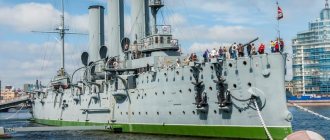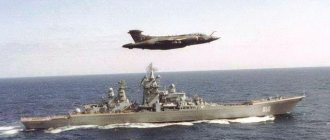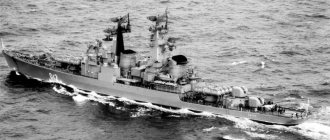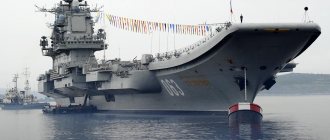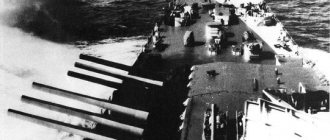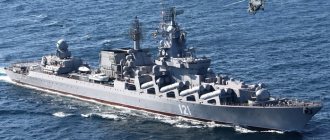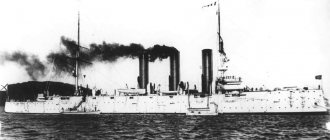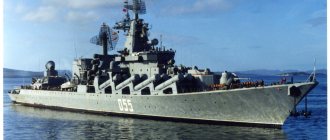The low October sky over a quiet northern city and the slender silhouette of a warship waiting for something... For more than 100 years, many representatives of the bourgeoisie and ruling circles of all countries have been shuddering from this picture. The armored cruiser Aurora, born at the beginning of the turbulent twentieth century, received the same turbulent biography.
The ship has not fought very many wars, but it has seen three wars, and its victories are those that would be enough for an entire fleet. “Aurora” is a ship that, in one shot, paved the way for a new historical era.
Marine reinforcement projects
Aurora is the goddess of the dawn. The romantic name given to the cruiser strangely predetermined the fate of his country. “Aurora” was born at the junction of eras. It was created for a time determined to divide by force an already divided world. But in fact, the cruiser launched the era of elevating those who were previously nothing to the top of the social ladder.
New cruisers, including the Aurora, were built as part of the military program to strengthen the Russian fleet in 1895. There were objective reasons for the arms race - Russia had information about the build-up of the Japanese fleet, and it was necessary to prevent foreign dominance in the Baltic Sea.
A future world war was in the air. The Triple Alliance had already been created, the process of forming the Entente began (in 1895 the Franco-Russian alliance was concluded). Spheres of influence had to be won from competitors - there were no more free places on the planet.
As part of the fleet strengthening program, it was planned to build 3 armored cruisers of the 1st rank. All of them received ancient names - “Diana”, “Pallada” and “Aurora”. Why they were called that is unclear, but the king personally gave the order.
Their laying took place in May 1897, on the same day, although construction did not proceed simultaneously. “Aurora” was considered a laggard - work on its construction was constantly behind schedule.
"Aurora", successor to "Aurora"
The first in the Russian fleet to receive the name of the Roman goddess of the dawn Aurora was on November 23, 1833, a sailing frigate of the Speshny type. This ship served Russia faithfully for 28 years and during this time managed to truly glorify its name. Thus, from August 21, 1853 to July 19, 1854, the sailing ship "Aurora" made its first circumnavigation, and from October 9, 1856 to June 1, 1857 - the second. Formally, both voyages took place as part of the frigate’s Far Eastern voyage, which lasted a total of more than three and a half years.
It also included Aurora’s participation in the defense of Petropavlovsk-Kamchatsky during the Crimean War. The frigate took part in naval battles with English and French ships, landed troops on enemy-occupied areas of the coast and repelled assaults on the port of Petropavlovsk, and in March 1855 helped evacuate, by order of the governor of Eastern Siberia, the residents, garrison and property of the Kamchatka capital to the Amur.
Technical characteristics and disadvantages of the ship
The design of the Aurora ship assumed that the cruiser would become a worthy rival to enemy ships. The description of its characteristics looked convincing for its time:
- Dimensions: draft – 6.2-6.4 m; width – 16.8 m; length – 126.7 m.
- Normal displacement is 6731 tons, full displacement is 7130 tons.
- Personnel – 570 people (including 20 officers). Crew numbers varied slightly during service.
- The power plant included three steam engines, each of which drove its own propeller. The total power was almost 12 thousand hp.
- The design speed was supposed to be up to 20 knots; in fact, the cruiser did not develop more than 19.2 knots.
- The cruiser's initial armament consisted of eight 152 mm/45 Kane guns, 24 75 mm Kane anti-mine guns (barrel length 50 calibers), and auxiliary artillery (eight 37 mm guns). To support the landing, there were two 63.5 mm Baranovsky cannons on wheeled carriages on board. Additionally, three 381 mm torpedo tubes were installed (one in the bow and one on each side). In 1904, the cruiser was equipped with a pair of 7.62 mm Maxim system machine guns.
- The ship's protection consisted of an armored deck with a thickness of 38 to 63.5 mm. The thickenings of the sheets were located above the critical sections of the structure. The command post was located in the conning tower, which had protection 152 mm thick. The shields installed later on the main caliber had a thickness of 25.4 mm.
- Cruising range in economy mode is 4000 miles.
But there are pitfalls hidden in these beautiful numbers. A speed of 20 knots was insufficient for a cruiser at that time (the same Varyag, according to the project, was supposed to produce 23 knots, and Askold showed 24.5 knots in tests). Tests have shown that the ship cannot even achieve this indicator - speeds above 19.2 knots were not recorded.
The cruiser's guns were deprived of armor protection. This drawback, however, was corrected before the ship entered the first battle - conclusions were drawn from the unfortunate fate of the same “Varyag”.
During the construction and service of the cruiser, changes were made to its weapons system. For example, the number of torpedo tubes was changed during the construction process - there were three instead of one. Significant changes were made during the First World War.
Description of design
Frame
The Aurora's hull has three decks: an upper and two internal ones (battery and armor), as well as a tank superstructure. There is a platform along the entire perimeter of the armored deck, which was called the living deck, and two more at the ends of the ship.
The main transverse bulkheads (below the armored deck) divide the interior of the hold into thirteen compartments. Four compartments (bow, boiler rooms, engine rooms, aft) occupy the space between the armor and battery decks and ensure the ship's unsinkability.
The outer steel skin was 6.4 m long and up to 16 mm thick and was attached to the kit with two rows of rivets. In the underwater part of the hull, steel sheets were fastened overlapping, in the surface part - end-to-end on backing strips. The thickness of the bulwark sheathing sheets reached 3 mm.
The underwater part of the hull and its surface part 840 mm above the waterline had a millimeter-thick copper plating, which, in order to avoid electrochemical corrosion and fouling, was attached to a teak wooden cladding secured to the hull with bronze bolts.
In the center plane, on a horizontal keel, a false keel was installed, which had two layers and was made of two types of trees (the top row was made of teak, the bottom row was made of oak).
The cruiser had two masts, the bases of which were attached to the armored deck. Foremast height - 23.8 m; mainmast - 21.6 m.
Booking
The design of an armored cruiser assumes the presence of a continuous carapace deck that protects all vital parts of the ship (engine rooms, boiler rooms and tiller rooms, artillery and mine ammunition magazines, a central combat post, underwater mine vehicle rooms). Its horizontal part on the Aurora has a thickness of 38 mm, which increases to 63.5 mm at the bevels to the sides and ends.
The conning tower is protected in front, on the sides and behind by armor plates 152 mm thick, which made it possible to protect it even from the aft heading angles; on top - armor plate 51 mm thick made of low-magnetic steel.
Vertical armor 38 mm thick has projectile elevators and control drives where there is no armor deck.
Power plant and driving performance
The boiler plant consisted of 24 Belleville system boilers of the 1894 model, which were located in three compartments (bow, stern and middle boiler room). The main steam pipeline to the main steam engines was laid along the sides of the cruiser. The Aurora, like other ships of its type, did not have auxiliary boilers. In view of this, steam was supplied to the auxiliary mechanisms through a steam line from the main boilers.
Above all three boiler rooms there was a chimney 27.4 m high. To ensure the operation of the boilers, the ship tanks contained 332 tons of fresh water (for the needs of the crew - 135 tons), which could be replenished using desalination plants of the circle system, the total productivity of which reached up to 60 tons of water per day.
To accommodate coal, the Aurora had 24 coal pits located in the inter-hull space near the boiler rooms, as well as 8 coal pits for spare fuel, located between the armor and battery decks throughout the engine rooms. These 32 pits could hold up to 965 tons of coal; 800 tons of coal were considered a normal fuel supply. A full supply of coal could last for 4,000 miles of sailing at a speed of 10 knots.
The main engines were three triple expansion steam engines (total power - 11,600 hp). They were supposed to be capable of 20 knots (during testing, the Aurora reached a maximum speed of 19.2 knots, which generally exceeded the maximum speed of the Diana and Pallada in testing). Condensation of the exhaust steam was carried out by three refrigerators; there was also a condenser for steam of auxiliary machines and mechanisms.
The cruiser's propellers are three three-blade bronze propellers. The middle propeller was a left-handed propeller, the right one rotated counterclockwise, the left one rotated clockwise (view from stern to bow).
Auxiliary equipment
- Drainage system
The purpose of the system is to pump out the bulk of water from the ship’s compartments after the hole has been repaired. For this purpose, one turbine (water supply - 250 t/h) was used autonomously at the ends, in the MKO - circulation pumps of refrigerators and six turbines with water supply of 400 t/h each.
- Drying system
The purpose of the system is to remove water remaining after the operation of drainage systems or accumulated in the hull due to filtration, flooding of bearings, sweating of sides and decks. For this purpose, the ship had a main pipe made of red copper, which had 31 receiving branches and 21 isolation valves. The drainage itself was carried out by three Worthington pumps.
- Ballast system
The Aurora had one flood system at the ends and two in the middle watertight compartments, which were controlled from the battery deck. The drives of the flooding kingstons were brought to the living deck.
- Fire system
A red copper fire main pipe was laid under the armored deck along the starboard side. Two Worthington pumps were used to supply water. Branches from the main pipe were located on the upper deck, turning into copper swivel horns for connecting fire hoses.
- Boat weapons
- two 30-foot steam launches;
- one 16-oar longboat;
- one 18-oar longboat;
- one 14-oar boat;
- one 12-oar boat;
- two 6-oar whaleboats;
- two yawls.
All rowing ships were served by rotating davits, and steam boats were served by tilting davits.
Crew and habitability
The living quarters were designed for 570 crew members (20 officers and 550 conductors and lower ranks) and to accommodate the flagship of the formation with its headquarters. The lower ranks slept on hanging bunks located in the bow of the ship, 10 conductors were located in five double cabins on the armored deck, officers and admirals - in rooms at the stern of the ship. The food supply was designed for two months.
Ceremonial start of the service
The laying and launching of the Aurora took place in a solemn atmosphere. Delays in the production of work did not affect this.
The cruiser left the slipway (in May 1900) in the presence of Nicholas II and two empresses - the dowager and the reigning empress.
The further progress of the work went worse. Completion and sea trials of the ship took another three years, and the cruiser entered service only in June 1903. The first trip to sea took place even later - in September of the same year.
As part of Admiral Virenius's squadron, the ship visited the ports of North Africa (Algeria, Suez). The trip revealed shortcomings and defects of steam engines, which had to be eliminated by the team and coastal specialists.
And then the ship’s history began to develop mysteriously. “Aurora” turned out to be both a loser and a phenomenally lucky one. She was constantly exposed to minor vicissitudes of fate, but remained relatively unscathed in serious trials.
History of construction
The type of cruiser Aurora is “Diana”, rank I. Cruisers of this type began to be ordered due to difficulties in foreign policy at the end of the 19th century. At first it was a geopolitical rivalry with England, called the Great Game. Then the situation in the Baltic worsened.
The tense political situation forced Russia to adjust the 20-year shipbuilding program, which was adopted in 1881. They ordered 3 cruisers with an armored deck - the Diana type, one of which was the Aurora. The production was carried out by the New Admiralty, the order was fulfilled by the Baltic Shipyard.
The prototype was the cruiser Talbot (England). Initially it was planned to build two cruisers - Diana and Pallada. This was the main job, and Aurora became an additional project, its construction was behind schedule.
The formation of the ship hull began in the fall of 1986. The steel was supplied by the Admiralty Izhora Plant, but it could not cope with the abundance of orders, so some of the materials for Aurora were supplied by the Aleksandrovsky Iron Foundry. A problem with materials was one of the reasons for the delay in construction.
The name "Aurora" appeared on April 12, 1897 by order of Nicholas II. There were 11 options in total, but he preferred the symbol of the Roman goddess of dawn.
The official laying date for the Diana-class cruisers was June 4, 1897. The ceremony was also held in Aurora. Admiral General Alexey Alexandrovich attended it. A silver plate was fixed between the frames, and the flag and jack were raised.
Due to a number of problems, the production of machines, boilers and various mechanisms began late. The contract for the work was signed only in July 1987. According to it, all work cost 2.275 million rubles.
Construction of the cruiser with sea trials took almost 8 years. This period was marked by the involvement of four officers of the Corps of Naval Engineers in the construction - de Grofe, Tokarevsky, Pushchin and Bazhenov.
Construction of a cruiser
In October 1897, the stem was installed. The Naval Ministry, represented by its manager Tyrtov, during a visit to the New Admiralty, ordered not to lag behind the construction of Diana and Pallas. In mid-1898, Aurora was 28% ready in terms of the hull, and almost 60% in terms of vehicles.
When the steam power plant was being manufactured, mechanical engineer Petrov became the senior officer, and officers and ship specialists appeared. They proposed changes in torpedo armament - now the cruiser had three 381 mm torpedo tubes. The production began at the St. Petersburg Metal Plant in the summer of 1898.
In the spring of 1990, the Aurora building was 78% ready. Various systems and devices were installed at the same time.
The date of the ceremonial launching of the Aurora was May 24, 1900. The ceremony was observed by Nicholas II with the empresses - his mother and wife. They were located in the Imperial Pavilion. The celebration was accompanied by artillery salutes fired by ships on the Neva.
After the ceremonial launch, the cruiser was towed to the Franco-Russian plant for installation of the main engines. At the same time, we worked on the steam pipeline, auxiliary mechanisms, and general ship systems. August 1990 is notable for the appearance of three chimneys, from which steam was already rising at the end of October.
In November 1900, a test of the machines was carried out, which proved that their operation was correct. They also carried out tests on the mooring lines, based on the results of which they signed Act No. 559 - the cruiser could move to Kronstadt. However, many works were not completed. The installation of the electric steering, tiller device, and steam steering engine has not begun.
In the summer of 1900, acceptance tests began on Pallas and Diana, which were significantly ahead of Aurora in terms of readiness. The commission identified a number of significant shortcomings and miscalculations, many related to the artillery unit. All these errors were taken into account and corrected during the completion of the Aurora.
During the construction of the Aurora, there was a shortage of labor, as shipbuilding was in full swing, with several projects being carried out simultaneously. Due to a number of shortcomings and a basic lack of experience, it was necessary to modify the fastenings and electrical equipment. Poorly manufactured vertical armor for the conning tower also had an impact, the modification of which took additional time.
The year 1902 is notable for the installation of Hall anchors - this was a novelty in domestic shipbuilding. The ship was fully ready in May, and the end of July was marked by the first voyage to Kronstadt. During this, the right propeller was slightly damaged.
Hall system anchor
Lucky of the Battle of Tsushima
The ship's first campaign was the Russo-Japanese War. And the cruiser’s biography strangely reflected the peculiarities of Russia’s position in this war. The Aurora became part of the squadron immediately upon its return to the Baltic.
The cruiser became one of the few ships in the squadron that had long-distance voyage experience.
At the same time, a change of commander occurs - he becomes captain 1st rank E.R. Egoriev.
The Aurora learned about the beginning of the war in the Far East on January 31, 1904, while staying in Djibouti. At the same time, an order to return was received. In April 1904, the ship returned to Kronstadt, and was immediately included in the squadron of Admiral Rozhestvensky, who was going to fight Japan.
The campaign began with a bad omen. On October 7, while passing by the British Isles, the squadron encountered fog. In conditions of poor visibility, the sailors confused the fishing ships and their own squadron comrades with the enemy and began shooting. At sea, such things are sarcastically called "friendly fire." There were casualties, and the ship's priest died on the Aurora.
This event, called the Ghull Incident, led to a major international scandal. And the squadron set off on its further journey with bad parting words. Her journey ended near the island of Tsushima.
Winner in a lost battle
The Battle of Tsushima was a disaster for the Russian fleet. But not for the cruiser Aurora. He took part in the battle, but remained afloat and escaped capture.
Admiral Rozhdestvensky, among his other mistakes, lined up the squadron incorrectly. As a result, many cruisers, including the Aurora, were unable to immediately enter the battle and help their own at the initial stage. But then the ship entered the battle and bravely resisted the attacks of Japanese cruisers on the transport ships of the Russian squadron. The flag on it was knocked down 6 times, but the team raised it again.
The ship received serious damage, but retained the ability to move independently.
At one point in the battle, the ammunition on it caught fire, but the serving sailors managed to prevent the ammunition from exploding. The cruiser managed to reach the Philippines under its own power, where it was interned by the US military. But the team was allowed to carry out repair work.
Personnel losses were significant. 10 people were killed, another 5 later died from their wounds. There were 80 people wounded. But even here bad luck happened - the only officer killed was Captain 1st Rank E.R. Egoriev, commander of the cruiser.
He was one of the first to die, and the cruiser fought under the command of first the senior navigator, and then senior officer A.K. Nebolsina.
Crew
The cruiser Aurora had a crew of 570 people - 20 officers, the rest conductors and lower ranks. The living quarters also provided for the placement of a flagship with headquarters.
For lower ranks there were suspended bunks in the bow of the cruiser, for conductors - 5 double cabins (armored deck). The officers were located in the stern of the ship. Food could be stored for 2 months.
On December 1, 2010, Aurora was withdrawn from the Navy. The military crew became a staff - 3 military personnel and 28 civilians.
Revenge for neglect
It turned out that near Tsushima, the Aurora took revenge in a unique way on the squadron commander, Admiral Rozhestvensky, for neglect. The squadron commander came up with various, often offensive, nicknames for all the ships of his formation. He did not hesitate to call the ships “Idiots” and “Sneaks” out loud. He especially “loved” “Aurora,” probably because of her feminine name. Therefore, in his vocabulary, a cruiser was designated as a sub-fence... lady with low social responsibility.
At the same time, unbiased eyewitnesses noted that the cruiser makes a good impression, the crew is hardworking and efficient, and order reigns everywhere.
The ship showed particular skill in loading coal and always had fuel in reserve.
Fate restored justice. The Aurora crew near Tsushima showed their best side, withstanding a decently dangerous battle and managing to save the ship. And Rozhdestvensky at the very beginning of the battle practically lost control over its course. After the end of the war, he was put on trial for unprofessionalism, which led to the death of the squadron, and was found guilty.
Fleet Rescue Service
Upon returning to Russia in 1906, the Aurora was put in for repairs - the work was not completed in Manila. During the work, the armament was changed - all the useless 37 mm artillery was removed, leaving only two installations on the boats, and two 75 mm guns were removed. Two more 75 mm guns were removed, and 152 mm guns were installed instead. A relic of the sailing fleet—the combat tops—disappeared, as well as the onboard torpedo tubes. Fire extinguishing systems and armor have undergone modifications.
Between the Russo-Japanese War and World War I, the Aurora performed somewhat unusual duties for a warship. Her team had to act as rescuers and firefighters.
In 1908, during an overseas raid, the ship's crew provided assistance to Italians affected by the famous Messina earthquake. In Italy, the help of Russian sailors was highly appreciated, and in 1910 they invited the cruiser to Messina in order to present the captain with a commemorative medal of honor.
But when the Aurora arrived in the city, a large fire suddenly started there. The cruiser's crew turned out to be more efficient than the Italian firefighters and were the first to begin extinguishing the fire. The Messinians did not have a second medal, and they expressed their gratitude in the form of 1800 oranges and the same number of lemons. With this pleasant cargo, the Aurora went to the Spanish port of Malaga, and well, a fire broke out there too, which the cruiser’s crew also struggled with.
The time free from rescue activities was devoted to diplomacy.
“Aurora” took part in the celebrations of the coronation of the monarch of Siam (1911), transported Grand Duke Boris Vladimirovich from Italy, and was part of a squadron demonstrating international support for Crete. An important component of the ship's service between the wars were training cruises with students of the Naval Corps.
Armament
Artillery weapons
The Aurora's artillery armament consisted of eight 152-mm guns of the Kane system with a barrel length of 45 calibers, placed one on the forecastle and poop and six on the upper deck (three on each side). The maximum firing range of the gun is up to 9800 m, the rate of fire is 5 rounds per minute with mechanical feeding of shells and 2 shots with manual feeding. The total ammunition consisted of 1414 rounds. According to their effect, shells were divided into armor-piercing, high-explosive and shrapnel.
On the upper and battery decks, twenty-four 75-mm guns with a barrel length of 50 calibers of the Kane system were installed on vertical machines of the Meller system. The firing range is up to 7000 m, the rate of fire is 10 rounds per minute with mechanical feed and 4 with manual feed. Their ammunition consisted of 6240 armor-piercing rounds. On the top and bridges there are 8 single 37-mm Hotchkiss guns and two 63.5-mm landing guns of the Baranovsky system. For these guns there were 3600 and 1440 rounds of ammunition, respectively.
Mine and torpedo weapons
Mine weapons included one surface retractable torpedo tube, which fired torpedoes through the stem, and two underwater traverse shield tubes installed on the side. Whitehead torpedoes were fired with compressed air at ship speeds of up to 17 knots. The torpedo tubes were aimed using three sights (one for each tube) located in the conning tower. The ammunition was eight torpedoes with a caliber of 381 mm and a range of 1500 m. Two of them were stored at the bow apparatus, another six were stored in the underwater vehicle compartment.
The mine armament also included 35 spheroconic barrage mines, which could be installed from rafts or boats and boats of the ship. On the sides of the Aurora, anti-mine barriers were hung on special tubular poles if the cruiser was anchored in an open roadstead.
Communications, detection, auxiliary equipment
External communication of the ship was provided by signal flags, as well as (less often) “Mangin battle lanterns” - searchlights with a mirror diameter of 75 cm. The main purpose of the latter was to illuminate enemy destroyers in the dark. "Aurora" was armed with six searchlights. For night long-range visual signaling, the cruiser had two sets of lights from the system of Colonel V.V. Tabulevich. This new tool for that time consisted of two lanterns, red and white. To enhance the light intensity of the lights, a special combustible powder was used, which made it possible, under favorable meteorological conditions, to see the lights at a distance of up to 10 miles. The signaling was carried out by transmitting numbers in Morse code: a dot was indicated by a flash of a white flashlight, and a dash by a red one.
Observation was carried out using spotting scopes and binoculars.
The cruiser's artillery fire control system allowed the artillery officer to control all of the ship's artillery and each gun individually. The distance to the target was measured using a Barr and Stroud system rangefinder purchased in England.
World War at an Inexpensive Price
Formally, the cruiser fought throughout the First World War - the Aurora was part of the 2nd Cruiser Brigade. But there were few real battles during this period. One of the few combat episodes was patrolling the site of the accident of the German cruiser Magdeburg.
As part of the brigade, the Aurora went on cruising patrols. But she had to take part in battles infrequently (mainly in the 1916 campaign).
At the beginning of the war, the ship was equipped with rails and a hangar for storing 150 mines. The composition of the weapons was also changed - 16 75 mm guns, which had become useless in battle, disappeared, and the openings in the sides were sealed. Instead, they installed four six-inch guns, borrowed from Diana. In the summer of 1915, new at that time “anti-aircraft” guns of 40 mm (one barrel) and 75 mm (four pieces) caliber were installed on the ship.
But in the fall of 1916 it was put under repair, and the imperialist war de facto ended for the Aurora.
Paid services
In the museum halls you can use the audio guide service:
- audio guide rental in Russian - 300 rubles;
- rental of an audio guide in a foreign language - 600 rubles.
When purchasing an audio guide, a deposit of 1000 rubles is required, or you can leave your driver’s license.
Virtual tour of the Aurora Museum on Google Panorama
Cost of photo and video shooting in the halls and exhibitions of the museum:
- amateur photography (mobile phones, tablets, cameras) without flash and use of a tripod - 100 rubles;
- video filming (amateur video camera) - 200 rubles;
- professional video shooting - 3000 rubles. per hour (by prior agreement).
If you plan to use photographs for professional or commercial purposes, then you need to coordinate the shooting with the museum administration.
© Julia
Less attractive target
The World War again demonstrated the strange luck of the ship. Similar interesting facts mark his entire biography.
During the First World War, the Aurora did not receive significant damage.
But her “sister” “Pallada” sank in a few seconds from being hit by a torpedo from a German submarine.
Similar luck accompanied the ship during the Great Patriotic War. The number of his crew at the start of the war was only 260 people, then it was further reduced (sailors were sent to the front from an outdated ship). But still it had 10 130 mm guns, 2 76.2 mm anti-aircraft guns, two general purpose guns of the same caliber, 3 45 mm guns. In July, as the enemy approached Leningrad, 9 out of 10 main caliber guns were brought ashore in the Duderhof area.
They were served by Auror sailors. The guns were called battery "A" (from the name of the cruiser). From the beginning of September 1941, the battery actively attacked the approaching enemy. On the 11th of the same month, she was attacked by the enemy, but held out for 8 days, and the sailors, due to a lack of ammunition, tried to damage the guns. Of the 165 battery personnel, only 25 survived the battle.
The cruiser itself was part of Oranienbaum's air defense system. Data on the results of its activities are inaccurate, but there is information that the Aurora managed to shoot down enemy aircraft.
At the same time, the Nazis did not pay much attention to her - just think, an ancient cruiser! And these are Nazis who understand the importance of ideology and the moral factor, dreaming of a symbolic parade on Red Square! For some reason they did not realize that the moral impact of the sinking of the Aurora on the Red Army and the citizens of the USSR would be no less than that of the fall of Moscow!
Of course, the ship was fired upon. The Aurora had been under fire (air and artillery) since mid-September. She received significant damage and even sat down on the ground. The commander, Captain 3rd Rank Sakov, decided to take the team ashore at the end of the month, but was arrested and shot “for alarmism.”
The team stayed on the cruiser until November, and then only the watch at the anti-aircraft gun was left.
However, the damage to the cruiser was not so serious that it sank. After the end of the blockade, the Aurora was removed from the ground and put in for repairs in 1944.
Prices for tickets to the Aurora cruiser museum in 2022
Entrance ticket for citizens of the Russian Federation and the CIS with inspection of the main exhibition:
- adults - 400 rubles;
- schoolchildren and students - 200 rubles.
Entrance ticket for foreign citizens with inspection of the main exhibition :
- adults - 600 rubles;
- schoolchildren and students - 400 rubles.
Preferential categories of visitors (free entry):
- Heroes of the Soviet Union;
- Heroes of the Russian Federation;
- disabled people of groups I and II;
- wheelchair users;
- large families (3 children or more);
- cadets of military educational institutions;
- students of the Suvorov and Nakhimov schools;
- students of cadet corps;
- employees of museums of the Russian Federation;
- children under 7 years old.
Tickets and audio tours
Detailed information about tickets and benefits on the official website of the museum
© Julia
Signalman of a new era
Children of the USSR listened to stories about the cruiser “Aurora” already in kindergarten. The reason was good - the ship was associated with the beginning of the revolution and was its recognized symbol.
Revolutionary sentiments arose on the ship even during the first Russian revolution, during the stay in the Philippines and immediately after returning to Russia. But then the officers managed to calm the sailors by promising them quick demobilization (this was fulfilled) and familiarizing them with the tsar’s manifesto of October 17. But the second revolution changed the situation.
During the beginning of the February Revolution of 1917, the cruiser was under repair near the Admiralty plant. The sailors decided to support the strike that began there. But the commander, M.I. Nikolsky, had a different point of view. When the sailors did not obey his order and tried to go ashore, he began to shoot at them with a revolver.
The matter ended badly - the rebel crew killed the captain. The riot also killed another officer. But this does not mean that anarchy has reigned on the Aurora. The commanders were now elected by the ship's committee, but the cruiser remained fully operational.
Otherwise, the Provisional Revolutionary Committee would not have instructed him to fire a shot on the evening of October 24, 1917, to signal preparations for the assault on the Winter Palace. To do this, it was necessary to move away from the factory pier and walk along the river, which would not have been possible without proper leadership and well-coordinated work of the team. The Aurora sailors also carried out work to demolish the Nikolaevsky Bridge, which had been erected by the cadets.
Excursion service
For all excursions it is necessary to purchase an additional entrance ticket for each visitor!
For citizens of the Russian Federation and the CIS:
- adult group up to 20 people - 250 rubles per person;
- group of up to 20 people (schoolchildren, students) - 100 rubles per person;
- thematic lecture-excursion for a group of up to 20 people - 300 rubles per person;
- author's or individual lecture-excursion for a group of up to 20 people - 2000 rubles per group.
For foreign citizens:
- sightseeing tour (group up to 20 people): in English - 500 rubles per person, in Russian - 400 rubles per person;
- thematic lecture-excursion (group up to 20 people): in English - 600 rubles per person, in Russian - 500 rubles per person;
- individual, author's lecture-excursion (group from 1 to 5 people): in English - 3000 rubles per group, in Russian - 2500 rubles per group.
Hotels near the cruiser Aurora
Kill shot at the past
A single shot near the Winter Palace immediately turned the Aurora into the most famous ship in the world. Many legends are told about him. The Soviet government considered it the starting point of a new historical era. After the collapse of the USSR, the Aurora gun was denounced as a criminal who dared to shoot at the cultural heritage of humanity. But few people know the details about this event.
There was a shot.
It was supposed to serve as a signal for the beginning of the final stage of the Bolshevik seizure of power. But not to storm the Winter Palace. The assault began later, and the cannon only transmitted the “combat readiness” signal.
It did not cause any damage to the Winter Palace building. By the time the revolution began in February, the ship was being repaired, and the military shells had been unloaded from it. Later they were not loaded due to revolutionary sentiments in the team.
The shot was blank and could not cause destruction! The goal was to capture the palace, not to destroy or damage it.
Tests
Factory tests began on August 8, 1902. They checked the main engines, eliminated deviations, straightened the damaged right propeller, and carried out other improvements.
On October 4, the cruiser was ready for acceptance tests. They officially began on October 10th. The commission identified a number of shortcomings that had to be corrected within 2 weeks.
The tests were repeated on October 25. They were successful, but the 6-hour full speed regime was not maintained, so the cruiser was withdrawn from the campaign, and the crew was transferred to barracks on the shore.
The next attempt was made on November 9, 1902. The cruiser passed the 6-hour test, but the vehicle was not accepted into the treasury due to discrepancies with actual operating conditions. The campaign was over, so the Marine Technical Committee took a long time to consider the matter. The decision was made only in March 1903 - the tests were postponed until the summer.
The final tests were carried out on June 14. The cruiser successfully withstood the 6-hour regime. In the following days, we made one more run - a total of 4 times. During this time, the contract speed was never achieved. The faults were easily fixed.
The cruiser has officially belonged to the Russian Imperial Navy since June 16, 1903. The tests revealed another drawback - the propeller shafts of the onboard engines were located in such a way that it was difficult to control the ship in narrow spaces.
At the beginning of July, the installation of the refrigeration unit began. On July 10, we made a control exit with testing of torpedo tubes. By September all that remained was to put the refrigeration machine into operation.
The last test was sailing from Kronstadt to the northern point of Bornholm (island) and back. The ship covered 1,158 miles in a continuous voyage. The voyage took 5 days (September 13-18). A control test proved the proper operation of all mechanisms.
The long odyssey of the symbol of revolution
After its legendary shot, the Aurora remained in service. In addition to participating in the Great Patriotic War, she managed to accomplish many more glorious deeds and play many controversial roles.
- In 1923, the Aurora was re-equipped. The 152mm main caliber was replaced by 130mm artillery.
- The cruiser sailed around the Scandinavian Peninsula in 1924 and arrived in Murmansk under a red flag. It had the same effect on other countries then as it might have on a bull in a bullfight.
- Since 1928, the Aurora became a training ship - at first underway, then (since 1935) laid up.
- The ship is the star of the screen. He played himself in the film “October” (1927) and “Varyag” in “The Cruiser “Varyag” (1946). For the sake of the last role, he was given an additional fake pipe (Aurora had 3 of them, and Varyag had 4). USSR animators created the cartoon “Aurora” even for the youngest viewers. It is now forgotten, but the song from it continues to sound: “The waves are steep, the storms are gray, such is the fate of the ships”...
- In 1948, Aurora became the residence of graduates of the Nakhimov School. Joining the cruiser's crew meant the last stage of preparation for them. At the same time, the Aurora became laid up on the Bolshaya Nevka. It was assumed that she would never leave this parking lot, but today changed the situation.
- In 1956, a museum was opened on the ship - a branch of the Naval Museum.
- Aurora was awarded the Order of the Red Banner and the Order of the October Revolution. The second award is all the more appropriate since the image of the cruiser is its most important part.
- The cruiser was depicted on the 1967 commemorative coins dedicated to the 50th anniversary of the revolution.
- After the collapse of the USSR, the cruiser turned into a recreation area for the “new” city leadership. This was not prevented even by the raising of St. Andrew's flag over it in 1992. But the ugliness did not last long. In 2010, Aurora finally acquired museum status. The ship is an object of Russian cultural heritage.
Evil tongues say that the current ship has nothing in common with the Aurora that fought near Tsushima and fired at Zimny. They say that numerous alterations turned it into a copy. Indeed, the old ship could not survive 100 years without major repairs. In addition to the mentioned upgrades, the cruiser's wooden hull parts and the metal plating of the underwater part were completely replaced (they rotted from time to time).
After being permanently parked, the running machinery and boilers were removed from it, and a significant part of the equipment was replaced with copies. The cruiser's guns are also copies - they only reflect the features of its original weapons. The guns were specially manufactured according to old drawings and installed on the cruiser for the sake of historical authenticity.
But it is not important. Now “Aurora” is not a combat unit, but a symbol. Its historical significance lies not in the age of the metal or the reliability of the equipment, but in the actions performed by the crew of this ship.
Today, its appearance is quite consistent with the historical one.
You can verify this by looking at the surviving photographs showing the Aurora from the time of the war with Japan and the campaign to Messina.
The role of "Varyag"
After the blockade of Leningrad was lifted in the summer of 1944, a decree regarding the cruiser appeared. It stated that the Aurora was to become a museum-monument to the history of the fleet and at the same time a training ship at the base of the Nakhimov School. Petrogradskaya embankment was chosen as its location. But the cruiser’s new life as a museum began with the filming of the film. In 1945, filming began on a film about the cruiser Varyag. This role was given to Aurora. To do this, a fake pipe and additional equipment were installed on it. In 1948, the cruiser was installed at the Nakhimov School on Bolshaya Nevka. After 1960, the cruiser was included in the number of state-protected monuments. At this time, the cruiser ceases to be the base of the Nakhimov School.
Veterans do not grow old at heart
You can have different attitudes towards the communist idea and the USSR. But there was something in the historical shot of the Aurora that does not allow the old ship to be relegated to the repository of history.
The whole world today knows where the cruiser Aurora is located and what it looks like. For 100 years, the scale of any historical event has been compared to its shot. Among the symbols of St. Petersburg, the Aurora ship is the youngest, but at the same time the most recognizable.
The silhouette of the cruiser is decorated with the Order of the October Revolution, which veterans of the Great Patriotic War and many important industrial enterprises are justifiably proud of. The older generation of Russians will never forget the purest young voice, the embodiment of their happy childhood: “What do you dream about, the cruiser Aurora, at the hour when morning rises over the Neva?”
In 2014, it was put under another renovation. Defense Minister S. Shoigu stated at the same time that, among other things, the cruiser would be given back running vehicles that had long since been replaced by mock-ups. Having exchanged the second century of age, “Aurora” is again ready to weigh anchor.
Every year on Navy Day, the old cruiser hosts a parade of Baltic ships - the unsinkable flagship of an invincible country.
Having officially become a museum, the Aurora has not lost its status as a warship - there are no contradictions here.
"Aurora" will not leave the city on the Neva. Maybe she has changed since her legendary shot. But the cruiser continues to symbolize the same idea - the fight for respect for work and working people. Patrols in black pea coats with a menacing name on their peaked caps are ready to come after those who profit unjustly and are greedy beyond measure. Is this what the old cruiser is dreaming about now?
Where is the cruiser now?
In the modern history of the ship, the latest event was the repair in 2014. On September 21, the cruiser Aurora in St. Petersburg was towed to the repair dock of the Kronstadt plant. The first stage of repairs was completed on November 26, after which it was towed to the extension wall to continue work.
The ship returned to its post on November 26, 2016, where the cruiser Aurora is now located. The legendary car appears in the form of a museum and a monument to the bloody events of human history in general and Russian history in particular.

